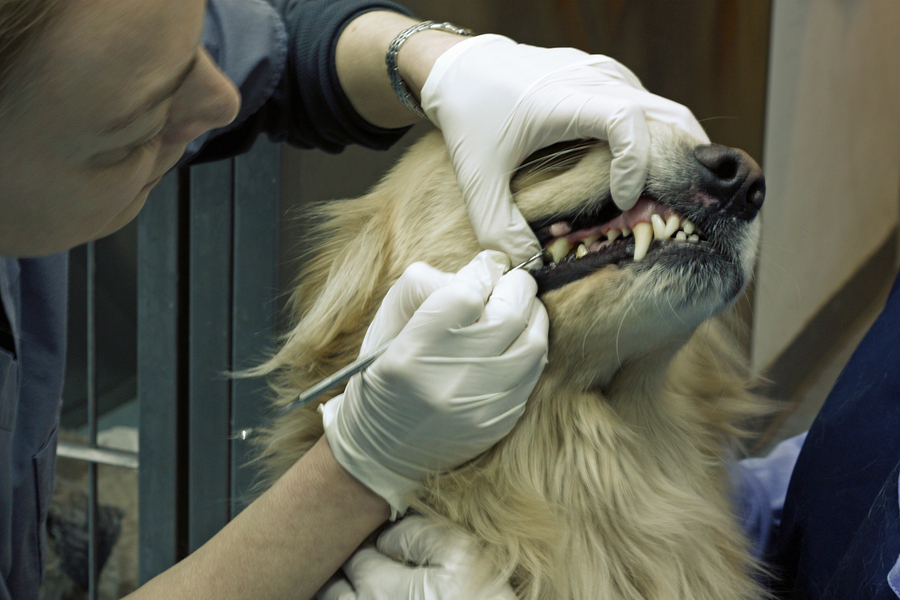
Halitosis, otherwise called doggy breath, is a frequent complaint among puppy parents. While bad breath is definitely a nuisance, it may also indicate your pet is at risk for more serious issues. At-home dental hygiene is an excellent way to slow down the effects of dental disease, but nothing is as effective as getting your pet’s teeth cleaned professionally.
What impact can dental disease have in your dog?
According to the veterinary book, DVM 360, periodontal disease is the most frequent health issue small animal practitioners see now. Statistics indicate 80 percent of canines have some kind of dental disease by age three.
Unfortunately for our puppies, periodontal disease means more than just bad breath. With time, plaque and germs spread beneath the gumline creating pockets of disease that break down and destroy teeth. As you can imagine, this process is painful and may result in poor appetite, weight loss, and depression.
In cases of complex dental disease, bacteria enters the blood, placing dogs at risk for more serious ailments such as heart disease and failure of the kidneys or liver.
Why is it important to have your pet’s teeth cleaned professionally?
What’s involved in a professional dental cleaning?
In the days — weeks prior to the process:
Your dog’s travel to dental health starts well before the day of the process. Veterinarians often notice symptoms of tartar buildup and periodontal disease during routine physical examinations. In other circumstances, the owner can bring the dog in especially to have its teeth assessed after discovering foul breath, drooling or difficulty eating.
In this first visit, your vet will explore the dangers and rewards of having your pet’s teeth cleaned.
You can also get an itemized estimate. Bear in mind, this is only an estimate! Prices may change once your veterinarian can analyze your dog’s mouth closely under anesthesia.
The day of the procedure:
Don’t offer meals after a certain period the evening before and the day of getting your dog’s teeth cleaned. This decreases your dog’s risk of nausea under anesthesia.
Give your puppy any prescription drugs unless your vet instructs differently.
When dropping off your dog, make certain to offer telephone number(s) in which the staff can reach you through the day.
During the process:
when your dog is under anesthesia, your veterinarian will conduct a comprehensive examination of the mouth.
Your pet will get oxygen and anesthetic gas via a tracheal tube. This instrument works by vibrating at a high rate.
He or she’ll use a hand scaler to remove smaller pieces of debris and to wash the faces of the teeth and under the gumline.
After eliminating all of the tartar and plaque, the vet will polish the surfaces of their teeth and apply fluoride.
The team will use blankets and body warmers to avoid a drop in your pet’s core temperature as he recovers from the anesthetic.
Most dogs can go home the same day with a few basic instructions.
As with any procedure involving general anesthesia, there’s always some level of risk. However, when you think about the outcome of complex dental disease, the benefits generally outweigh this concern.
However, you still need to do your homework prior to getting your dog’s teeth cleaned. During the preliminary visit, ask your veterinarian to clarify the procedure and talk about your dog’s individual anesthetic risks.
Why not more owners have their dog’s teeth cleaned?
Many owners do not even consider getting their dogs’ teeth cleaned till they detect tell-tale indications like bad breath or difficulty chewing. Since dogs frequently hide their distress, they may not receive treatment until their dental health has deteriorated.
Prices depend on several factors such as where you live and the intensity of your pet’s dental disease. Prices may vary from a few hundred dollars to well over a million when you factor in high-cost things such as anesthesia, X-rays, and complex extractions.
Although it’s perfectly normal to stress, dental procedures are usually quite safe. As discussed above, don’t hesitate to ask questions about what precautions the employees take to protect the dogs in their care